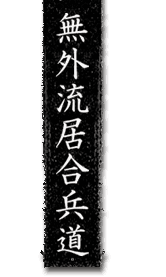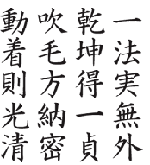 |

Tsuji Gettan Sukeshige tells us nothing concrete about the way of Mugai. However, he recounts that he saw Mugairu in an expression similar to the phrase "sword and zen are one truth" (kenzen ichi nyo).
A complete existence is united with the sword. That is to say, in the end there is only one existence (or "one life"), and even though it can be said that the manifestations of sword techniques are endless, one always returns to the "one truth," or "one way." Gettan asserts that to grasp the concept of the "one sword" requires many years. To stray slightly from topic, it is generally (and oddly enough, widely) believed that Mugairyu = Iaido. While this is not completely incorrect, it is a fact that the founder, Tsuji Gettan Sukeshige did not establish the Mugairyu-iai of today.
Today's Mugairyu Iaido was established by Takahashi Hachisuke Mitsusuke and his younger brother, Hidezu. In the mid-Edo period, in Tosa (present day Kochi prefecture), the family of the Governor Yamanouchi had a deep relationship with Mugairyu, and through this relationship, they are well known today. But Hachisuke and his brother began learning Mugairyu under fourth generation Mugairyu practitioner, Tsuji Bunzaemon Sukekata. The brothers of Takahashi were learning Jikyoryu from fifth generation master, Yamamura Masashige, while living in Tosa. This is a clue to the introduction of iai in Mugairyu. In September of the sixth year of Bunka (1809), Hachisuke died at the age of 60. Therefore, there was no iai in the Mugairyu established by Gettan [compare dates below].
Tsuji Gettan was born in the first year of Keian (1648) in the town of Masugimura, Omi (Shiga prefecture) as the second son of a local samurai. He was called Sukeshige (sometimes read Sukemochi); the name Gettan was the name he took as a young man and Mugai was a penname he used later.
Gettan left his home at the age of 13 in the third year of Manji (1660) and went to Kyto where he prepared to train at the Yamaguchi-ryu dojo. The teacher he revered, Bokushinsai Yamaguchi, began his training in Kashimashinto-ryu and later learned such styles as Shinkage-ryu and Awaga-ryu. He then contrived to establish his own Yamaguchi-ryu. However, aside from stories regarding Gettan, it is safe to say that there are no records for Yamaguchi-ryu along with the name Bokushinsai. In all likelihood, similarly as there would be later with Gettan's kenjutsu, there is a strong possibility that the old traditions of the Warring States Period (as followed by Yamaguchi) caused the popularity of the style (and its founder) to wane.
Gettan learned from Bokushinsai for 13 years. He was allowed "kaiden" (full transmission) at 26 years of age in the second year of Enpo (1674).

ADVANCEMENT THROUGH ASCETIC TRAINING
With his teacher's Yamaguchi-ryu, Gettan left for a journey to wander around the country as a Shugyosha [one who trains in ascetic budo practices]. However, perhaps because he was not satisfied with his skills as a swordsman, he soon confined himself to areas like Mt. Atago on the outskirts of Kyoto and Mt. Aburahidake in the Omi region. He devoted himself to his training.
Mt. Atago is a craggy mountain that towers above the border of Yamashiro (southern Kyoto) and Tanba (the area straddling Kyoto and Hyogo). He purified his body in the clean and icy waters that wash through the foothills and practiced batto [drawing the sword] and noto [sheathing the sword] a thousand times everyday in the mountains. Moreover, he also surpassed seven days with only water that he found in bamboo shoots. Then Gettan descended from Mt. Atago, decided to give up the Kinki region (Kansai/western Japan), and left for Edo [present day Tokyo]. He decided to open his own dojo.
Around this time, Gettan was cultivating sword techniques rendered from the Sengoku [Warring States] period. Through severe training, he tempered his mind and body, and with this spirit there is no doubt that he was filled with confidence that there would be no enemies where he was headed. It is safe to say that with this increased confidence he did not trouble himself with his appearance.
Many episodes have been told about Gettan and we will introduce one episode here. Around the time when he left for Edo, the shoulders of his haori were frayed, the pleats of his hakama were so shabby that they could not be found, the hem of his faded kimono was sticking out and dragging on the ground, and the straw hat that he wore was ripped. His hair, which was not greased up at all, blew in the gentle breeze.
One day, while Gettan was walking through central Edo, several young bushi (warriors) passed him. They decided to tease him about his strange appearance. One of them blurted out something like, "Do you and I have a problem, pal?!"
Gettan stopped and calmly removed his hat. His hair-tie was cut and his hair was thick and unkept, and the light in his eyes was piercing. He was a dreadful sight. The young bushis' breath was instantly taken away. They turned pale and ran away as fast as they could.
The ferocity of his sword was widely known around town, yet despite Gettan eventually opening a dojo in Edo's Kojimachi district, there were indeed no bushi who entered his school. So there was a lack of funds for daily necessities. One day after Gettan finished training and was resting, the house boy came to him and requested that Gettan teach him sword. Gettan calmly replied, "I'm a little tired. Let's do it next time," but in his heart he worried, "I look down on this poor man too much." He then came to realize that even now he was a slave to this world."Had he not been a servant, would I have refused to train him? There is no mistake that especially because he is a servant, I thought he was making light of me." And thuse Gettan returned to the dojo and trained as requested. This episode only allows us to catch a glimpse of Gettan as a seeker of truth, but it is a terribly interesting episode.
KEN ZEN ICHI NYO (SWORD AND ZEN ARE ONE TRUTH), COMING TO MUGAIRYU
Gettan wanted to learn all he could about the mysteries and secrets of the sword, and like Musashi Miyamoto before him, he was attracted to the "sword and zen are one truth way." When Gettan performed zazen (seated zen meditation) at the Tsukozan Kyukoji temple in Sakuratacho, Azabu, he used zen master Sekitan as his teacher and groped for his own sword method.
In the sixth year of Genroku (1693) Sekitan entrusted Gettan with further teachings and all became clear to Gettan.

|
Ippo jitsu mugai
Kenkon toku ittei
Suimo hono mitsu
Dochaku soku kosei |
There is nothing but the one truth: |
| It is universal, constant. |
| The wind-blown feather truly obtains this secret; |
| To know harmony amidst confusion is to be illuminated.. |
Gettan used the term "mugai" from this teaching and called his style "Mugairyu." After all, this way leads to absolute truth, so there is nothing beyond "the way." Gettan had been sitting zazen for 19 years since he began, and he was now 45 years of age.
Along with the founding of Mugairyu, Gettan's name began to rise in popularity. Considering encounters (matches or bouts) to be of high importance, the Kojimachi dojo gained support from bushi that detested cheap kata practice. It was a slow process, but the number of new students increased.
Incidentally, we wonder just what kind of "sword" was Gettan's established Mugairyu? We touched on this earlier, but even though it is common to associate modern Mugairyu with iai, this iai is not what Gettan started. In other words, Gettan was focused on kenjutsu. It is thought that the section of the Mugairyu Shinden Kirigami written below offers an explanation.
This style of sword differs greatly from other styles. The techniques of Mugairyu are much like that of actual combat. Not only through observation and devotion to training, but through the absolutely essential experience of victory and defeat, along with accumulated time (training time) can the secrets of the way be reached.
HIS FOLLOWING INCREASES, BUT THE WAY IS UNCLEAR
Nevertheless, we do not know the techniques of Mugairyu. Despite the fact that Gettan's published manual Mugai Shinden Kenhoketsu lists the kata Shishioken, Hanshato, Shinmyoken, Suigetsukanno, Gyokurenfudan, Banbokkiitto, etc. as the "ten principles," they are mainly told as devine revelations, so nothing concrete is told about the actual method of swordsmanship. Gettan says "The swordsmanship of mugai shinden has zen principles." This is extremely sublime, but there is no mistaking that he viewed Mugairyu as being an equation of "swordsmanship plus life" in his expression "Sword and Zen are One Truth." A complete existence is united with the sword: To understand this "one way/sword," Gettan maintains that much time is needed.
Accordingly he states, "Progress for Thirty Years."
Along with Mugairyu's enhanced reputation, among Gettan's students were daimyo (regional governors) as well as jikisan, (samurai directly connected or employed by the shogun). His connection to the Yamanouchi family in Tosa was a particularly close one.It is written in the Yamanouchi family diary that during the rule of the fifth generation Lord of Tosa, Yamanouchi Toyofusa, "Tsuji Gettan was invited to lead training in his sword strategy," in the fourth year of Hoei (1707).
In the sixth year of Hoei as Gettan was approaching his 60th birthday, famous daimyo such as Ogasawara Sadorinokami Nagashige, Sakai Utanokami Tadataka, and the aforementioned Yamanouchi family could be counted among his students. His students also included an additional thirty shomyo (like daimyo who govern smaller regions), around 150 jikisan, and over 900 vassels.
Furthermore, this was the year when Gettan was invited to appear before the shogun, fifth generation of the Tokugawa family, Tsunayoshi Tokugawa.
Relying on the arrangements made by Sakai Utanokami, the year before under the supervision of the head of Hayashi University, permission had been given for the submission of a request to appear before the shogun. Of course, it goes without saying that if one was not at least a Jikisan this was absolutely not in accord with the practices of the time. Surely nothing surpassed this in terms of prestige for Gettan. Unfortunately however, the following New Years due to the death of shogun Tsunayoshi, this appearance before the shogun did not become a reality. On June 23rd, in the twelfth year of Kyoho, Tsuji Gettan Sukeshige passed away at the age of 77. He was given the post-humus Buddhist name, "Mugai-shi Ippo Kyoshi." He was laid to rest at the Daiunin of Nyotaiji temple in the Takanawa area of Edo.
|
|